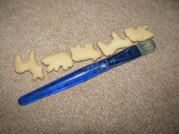Non-Standard Measurement Skills
Summary
Students will measure objects using everyday household items: paper clips, toothpicks, Popsicle sticks, and more. They will work on choosing the right measuring tool for the size of the object, not mixing tools while measuring an object, and starting to measure at the end of an object not in the middle.
Materials
Attachments
-
nonstandardmeasurementdatasheet.pdf
Non-Standard Measurement Data Sheet
- Have 5 containers of different measuring tools for each table. Some examples are: paper clips, tooth picks, Popsicle sticks, pennies, gram cubes, washers, and cotton swabs. Any items can be used, just be sure you have an assortment of lengths in your tools.
- At each table have about 15 assorted objects for the kids to measure; some can be round, square, rectangular or irregularly shaped.
Background for Teachers
Measuring is an important science skill. Before students use a ruler they can measure with everyday objects. A student can measure a book and find it to be 15 paper clips long. As they measure a book with paperclips they will use three rules for measuring: place the first tool at the end of the object, each tool must touch end to end in a straight line, and they can only use one tool at a time to measure an object. Students will be measuring without having to understand the markings on a ruler.
Intended Learning Outcomes
- Conducting investigations. Collecting data. Drawing conclusions.
- Sharing ideas with peers. Using multiple methods of communicating reasons/evidence.
- Differences in conclusions are best settled through additional observations and investigations.
Instructional Procedures
Pre-lab discussion:
Show students several of the measuring tools and an object to measure. Act out the three rules and see if students can discover the rules with you. Mix measuring tools for one object and students will decide that doesn't make sense. Start measuring in the middle of an object and students will understand that you won't measure an entire object if that is done. Use a tool that is too long or too short to measure an object and students will suggest that a different tool be used.
Instructional Procedures:
- Show the students the measuring tools at their table. Some students may not know all their names so be sure and go over them.
- Hand each student a container of a measuring tool and an object to measure.
- Students should follow the measuring rules explained and then report to the
adult at the table how long their object is. Be sure students give their unit
after the number. For example, "this wooden block is 10 pennies long".

- Students should describe the length of their object to the nearest unit. They can use words such as: almost, between, close to or about. If students understand the concept of 'a half' let them use that as well.
- After students complete each object have them chose another object and measuring tool. Help them choose the best measuring tool for the job. If it is a large object use a large measuring instrument and vice versa.
- Towards the end of the activity, have students predict the length of an object using one of the tools. See how close they come to their prediction.
- When students get done measuring the objects at their table they can also measure objects around the classroom and even measure the other students in their group by measuring them on the floor.
Assessment Plan
Attachments
Bibliography
Rio Tinto Hands-on Science Curriculum Team
- Ms. Rae Louie -- Administrator, Principal Beacon Heights Elementary
- Emily Mortensen -- Grant writer, teacher outreach, 2nd grade teacher at Beacon Heights Elementary
- Ruth Li -- Curriculum design, K-6 Science Educator at Indian Hills Elementary
- Deirdre Straight -- Curriculum development, K-6 Science Educator at Beacon Heights Elementary
- Tim Rausch -- Website development, Library Media at Beacon Heights Elementary
Updated: 10/17/2022


 UTAH EDUCATION NETWORK
UTAH EDUCATION NETWORK

 Justin
Justin Braxton
Braxton Dani
Dani Kayla
Kayla Katie
Katie Matthew
Matthew Rob
Rob Val
Val
